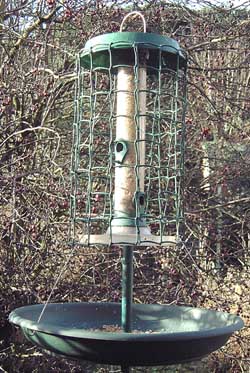The feeder is a centre of attraction for hungry birds in the garden. However, it became a frequent food source for Wood Pigeons who would enpty the thing faster than I could fill it (almost!). To restrict their feeding I fitted a green mesh 'cage', attached to a flower pot base at the top. This has a slot cut in it to fit over the handle at the top of the feeder, so that it can be removed easily. The bottom of the cage just hangs loosely around the feeder's tray.
The cage has completely stopped the use of the feeder by Starlings, Wood Pigeons and Collared Doves so I have to ensure that they are catered for elsewhere.
The Sparrows are very untidy feeders and spill a lot of seed. After attempting various arrangements to cope with this, my current solution is to suspend a large flowerpot tray about 8in below the feeder tray. This is suspended with three stainless steel rods which can be unhooked.
This tray has been very successful in greatly reducing the spillage from the feeder. The sparrows are grateful for a second chance to eat food from the feeder and often crowd around the edge of the tray. It is also visited by the Collared doves on a regular basis - through the Winter I have been putting peanuts into it for them. Although these are ignored by the Blue Tits I shall stop doing this when nesting starts and provided chopped peanuts instead.
As far as I can tell there is very little spillage onto the ground from the arrangement, other than empty husks.
The bird table has a cage of green plastic over it to keep off the bigger birds. So far I have only seen one starling venture in but the smaller birds visit freely.
There are two lengths of garden wire stretched between the two long side of the cage. They rest on the table and allow easy removal of the cage for table cleaning.
For the yr.2000 season
I set up a small mealworm feeder for the blue tits near the house.
It worked well, but this spring it was discovered by the starlings
and I had to defend it (see Yr2001 blue tit diary for April).
I am now trying a different feeder that I found on the American 'About Birding' site and it seems to be
working well.
Made from scrap wood, Its basic dimensions are:
base piece: 6.5 x 6in
ends: 6in wide; height(apex) 7.25in; height(side) 5.25in
holes: at both ends; 1.5in diameter; centre 5in above
bottom.
roof pieces: 10 x 4in; one side screwed to box, other
side hinged to allow filling.
Clear plastic side panels fit into slots cut in timber
and are marked with felt pen.
Metal 'c' section pieces are attached to both ends insde
to prevent mealworms escaping. These need to be tight fitting
against the sides.
